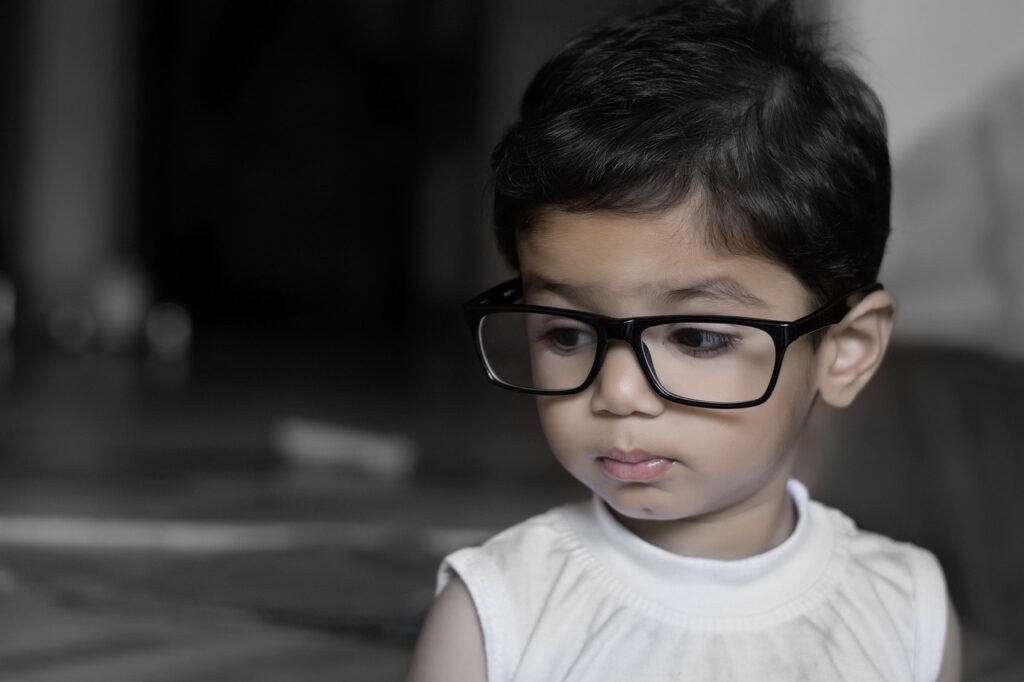The best way to determine whether a baby requires glasses
INFANT VISION HEALTH
In the early stages of an infant’s life, they are experiencing a great deal of growth. During this time, they are developing their physical abilities, including their eyes. The ability to recognize faces, track object movements, and coordinate hand-eye movements are all examples of visual skills.
When a baby has trouble developing specific visual skills, it may indicate a problem with their eye health or vision. However, vision development milestones can help eye care providers and parents understand how their child is progressing.
An eye examination for children is an important part of the child’s development. An eye exam allows an optometrist to monitor changes in a child’s vision and recommend appropriate treatment, including eyeglasses, if necessary.
A FIRST EYE EXAMINATION
As a result of their first eye exam, you can determine if your baby needs glasses. Children should be examined between 6–9 months of age by the Canadian Association of Optometrists (CAO) and the Alberta Association of Optometrists (AAO). Children should be examined between the ages of 2 and 5.
The recommended ages relate to how a child’s vision usually develops. Depending on how an infant compares to other children of their age group, optometrists can evaluate their vision, as well as their previous assessments of their vision. Moreover, optometrists can monitor changes and progression in order to understand an individual’s unique eye care needs.
In the course of the first seven to eight months of a baby’s life, he or she has passed a number of vision-related milestones. For instance, by the time of the first recommended eye examination, a child should be able to:
-
Recognize faces and objects
-
See full color & favorite colors
-
Observe images or objects from a distance of a few feet
-
Follow objects with their heads
Infants between the ages of 7 and 12 months can:
-
Play peek-a-boo
-
Recognize smaller objects
-
Perceive nearby objects in depth (depth perception)
-
Be able to track fast-moving objects
Typically, infants are not able to focus on objects closer than two feet during their first eye examination because they do not possess depth perception, clear distance vision, fine motor skills, or depth perception. Because babies in this age group have not developed the skills to deal with myopia or hyperopia, it should not be unexpected that they will require glasses.
As children progress to their second recommended eye exam, between 2 and 5 years of age, they will be able to test their distance and close vision more accurately. Although optometrists recommend a minimum of one eye exam at this age, children may need additional exams if there is a problem with their vision.
Infants develop binocular vision and depth perception between the ages of 2 and 3 years old. Their distance vision typically improves and approaches 20/20 by the age of 3 or 4. Infants are also capable of recognizing complex shapes, seeing objects close to their faces, and developing gross motor skills as they approach 3 to 4 years old.
It is important for your baby to undergo an eye examination between the ages of two and five years old in order to determine whether glasses are necessary to correct distance or close-up vision. However, babies may need glasses earlier if they suffer from other eye problems, such as amblyopia (lazy eye).
VISUAL PROBLEMS & SIGNIFICANCES
There are several signs and symptoms that parents can monitor at home to help determine when children’s eye exams should be scheduled. Optometrists are trained and educated to diagnose visual problems.
The following are common signs and symptoms to watch for:
-
Turning in or out of an eye
-
There is a lack of concentration (compared to age group)
-
Avoid reading, watching television, or engaging in activities that involve vision
-
The act of covering or closing one eye
-
Rubbing the eyes
-
Blinking or squinting frequently
-
Visually inspecting objects by holding them close
-
Sensitivity to light
-
Eyes that are red, itchy, or watery
-
Looking through a tilted head
If you observe any of these symptoms in your child or if you suspect they may have an eye condition, make an appointment to have a children’s eye exam. Even if your child has 20/20 vision, regular eye health examinations are important for monitoring their visual development and health.
THE FIRST GLASSES OF A CHILD
An infant’s first experience with glasses may be especially challenging. Parents may be able to explain the rules and benefits to their older child, but a newborn is more likely to consider their new glasses toys.
You may find that your infant is reluctant to wear glasses at first. They may have gotten used to how they normally see, so they may find them strange to look at through glasses. It may take your infant up to two weeks to become comfortable with wearing glasses.
It is common for babies to pull or toss their glasses, since the materials are designed to withstand the curiosity and clumsiness of babies. The glasses can also be fitted with an elastic band or a wrap-around design to help keep the glasses in place for infants and toddlers.
Ask your optometrist for tips if your child is having difficulty wearing their first glasses. You may need to give your child some time before they are able to adjust to their new vision.
In addition to keeping your child’s eyes healthy, it is important to keep your baby’s vision healthy. Approximately 80% of a child’s learning is visual, so knowing their vision and eye care needs from a young age can benefit them in the long run.
















